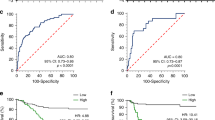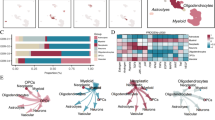Abstract
Epigenetic biomarkers are emerging as determinants of breast cancer prognosis. Breast cancer cells display unique alterations in major cellular metabolic pathways and it is becoming widely recognized that enzymes that regulate epigenetic alterations are metabolically sensitive. In this study, we used microarray data from the GEO database to compare gene expression for regulators of metabolism and epigenetic alterations among non-invasive epithelial (MCF-7, MDA-MB-361, and T-47D) and invasive mesenchymal (MDA-MB-231, Hs-578T, and BT-549) breast cancer cell lines. The expression of genes, including GLS1, GFPT2, LDHA, HDAC9, MYST2, and SUV420H2, was assessed using RT-PCR. There was differential expression between epithelial and mesenchymal cell lines. MYST2 and SUV420H2 regulate the levels of the epigenetic biomarkers histone H4 lysine 16 acetylation (H4K16ac) and histone H4 lysine 20 trimethylation (H4K20me3), respectively. Reduced amounts of H4K16ac and H4K20me3 correlated with lower levels of MYST2 and SUV420H2 in mesenchymal cells and, along with reduced amounts of histone H3 lysine 9 acetylation (H3K9ac), were found to distinguish epithelial from mesenchymal cells. In addition, both GLS1 and GFPT2 play roles in glutamine metabolism and were observed to be more highly expressed in mesenchymal cell lines, and when glutamine and glutamate levels reported in the NCI-60 metabolomics dataset were compared, the ratio of glutamate/glutamine was found to be higher in mesenchymal cells. Blocking the conversion of glutamine to glutamate using an allosteric inhibitor, Compound 968, against GLS1, increased H4K16ac in T-47D and MDA-MB-231 cells, linking glutamine metabolism to a particular histone modification in breast cancer. These findings support the concept that metabolically sensitive histone modifications and corresponding histone modifying enzymes can be used as diagnostic and prognostic biomarkers for breast cancer. It also further emphasizes the importance of glutamine metabolism in tumor progression and that inhibitors of cellular metabolic pathways may join histone deacetylase inhibitors as a form of epigenetic therapy.




Similar content being viewed by others
References
Jemal A et al (2011) Global cancer statistics. CA Cancer J Clin 61(2):69–90
Easton DF et al (1993) Genetic linkage analysis in familial breast and ovarian cancer: results from 214 families. The breast cancer linkage consortium. Am J Hum Genet 52(4):678–701
Nanda R (2007) Targeting the human epidermal growth factor receptor 2 (HER2) in the treatment of breast cancer: recent advances and future directions. Rev Recent Clin Trials 2(2):111–116
Sparano JA, Paik S (2008) Development of the 21-gene assay and its application in clinical practice and clinical trials. J Clin Oncol 26(5):721–728
Hanahan D, Weinberg RA (2011) Hallmarks of cancer: the next generation. Cell 144(5):646–674
Trimboli AJ et al (2008) Direct evidence for epithelial–mesenchymal transitions in breast cancer. Cancer Res 68(3):937–945
Birchmeier W, Behrens J (1994) Cadherin expression in carcinomas: role in the formation of cell junctions and the prevention of invasiveness. Biochim Biophys Acta 1198(1):11–26
Thomson S et al (2005) Epithelial to mesenchymal transition is a determinant of sensitivity of non-small-cell lung carcinoma cell lines and xenografts to epidermal growth factor receptor inhibition. Cancer Res 65(20):9455–9462
Kashiwagi S et al (2010) Significance of E-cadherin expression in triple-negative breast cancer. Br J Cancer 103(2):249–255
Giunciuglio D et al (1995) Invasive phenotype of MCF10A cells overexpressing c-Ha-ras and c-erbB-2 oncogenes. Int J Cancer 63(6):815–822
Gilles C et al (1999) Vimentin contributes to human mammary epithelial cell migration. J Cell Sci 112(24):4615–4625
Kim HJ et al (2007) Constitutively active type I insulin-like growth factor receptor causes transformation and xenograft growth of immortalized mammary epithelial cells and is accompanied by an epithelial-to-mesenchymal transition mediated by NF-kappaB and snail. Mol Cell Biol 27(8):3165–3175
Chua HL et al (2007) NF-kappaB represses E-cadherin expression and enhances epithelial to mesenchymal transition of mammary epithelial cells: potential involvement of ZEB-1 and ZEB-2. Oncogene 26(5):711–724
Hinshelwood RA, Clark SJ (2008) Breast cancer epigenetics: normal human mammary epithelial cells as a model system. J Mol Med 86(12):1315–1328
Dworkin AM, Huang TH, Toland AE (2009) Epigenetic alterations in the breast: implications for breast cancer detection, prognosis and treatment. Semin Cancer Biol 19(3):165–171
McCormick F (2001) Cancer gene therapy: fringe or cutting edge? Nat Rev Cancer 1(2):130–141
Ellis L, Atadja PW, Johnstone RW (2009) Epigenetics in cancer: targeting chromatin modifications. Mol Cancer Ther 8(6):1409–1420
Burgio G, Onorati MC, Corona DF (2010) Chromatin remodeling regulation by small molecules and metabolites. Biochim Biophys Acta 1799(10–12):671–680
Teperino R, Schoonjans K, Auwerx J (2010) Histone methyl transferases and demethylases; can they link metabolism and transcription? Cell Metab 12(4):321–327
Wellen KE et al (2009) ATP-citrate lyase links cellular metabolism to histone acetylation. Science 324(5930):1076–1080
Gao Z, Xu CW (2011) Glucose metabolism induces mono-ubiquitination of histone H2B in mammalian cells. Biochem Biophys Res Commun 404(1):428–433
Klose RJ, Kallin EM, Zhang Y (2006) JmjC-domain-containing proteins and histone demethylation. Nat Rev Genet 7(9):715–727
Wang JB et al (2010) Targeting mitochondrial glutaminase activity inhibits oncogenic transformation. Cancer Cell 18(3):207–219
Livak KJ, Schmittgen TD (2001) Analysis of relative gene expression data using real-time quantitative PCR and the 2(-Delta Delta C(T)) method. Methods 25(4):402–408
Choi YL et al (2010) LYN is a mediator of epithelial–mesenchymal transition and a target of dasatinib in breast cancer. Cancer Res 70(6):2296–2306
Bhattacharya S, Mariani TJ (2009) Array of hope: expression profiling identifies disease biomarkers and mechanism. Biochem Soc Trans 37(Pt 4):855–862
Richardson AD et al (2008) Central carbon metabolism in the progression of mammary carcinoma. Breast Cancer Res Treat 110(2):297–307
Petrie K et al (2003) The histone deacetylase 9 gene encodes multiple protein isoforms. J Biol Chem 278(18):16059–16072
Tao R et al (2007) Deacetylase inhibition promotes the generation and function of regulatory T cells. Nat Med 13(11):1299–1307
Taipale M et al (2005) hMOF histone acetyltransferase is required for histone H4 lysine 16 acetylation in mammalian cells. Mol Cell Biol 25(15):6798–6810
Schotta G et al (2004) A silencing pathway to induce H3-K9 and H4-K20 trimethylation at constitutive heterochromatin. Genes Dev 18(11):1251–1262
Secombe J et al (2007) The trithorax group protein Lid is a trimethyl histone H3K4 demethylase required for dMyc-induced cell growth. Genes Dev 21(5):537–551
Tryndyak VP, Kovalchuk O, Pogribny IP (2006) Loss of DNA methylation and histone H4 lysine 20 trimethylation in human breast cancer cells is associated with aberrant expression of DNA methyltransferase 1, Suv4-20h2 histone methyltransferase and methyl-binding proteins. Cancer Biol Ther 5(1):65–70
Michishita E et al (2008) SIRT6 is a histone H3 lysine 9 deacetylase that modulates telomeric chromatin. Nature 452(7186):492–496
Schwer B et al (2010) Neural sirtuin 6 (Sirt6) ablation attenuates somatic growth and causes obesity. Proc Natl Acad Sci USA 107(50):21790–21794
Mao Z et al (2011) SIRT6 promotes DNA repair under stress by activating PARP1. Science 332(6036):1443–1446
DeBerardinis RJ et al (2007) Beyond aerobic glycolysis: transformed cells can engage in glutamine metabolism that exceeds the requirement for protein and nucleotide synthesis. Proc Natl Acad Sci USA 104(49):19345–19350
Elsheikh SE et al (2009) Global histone modifications in breast cancer correlate with tumor phenotypes, prognostic factors, and patient outcome. Cancer Res 69(9):3802–3809
Esteller M (2008) Epigenetics in cancer. N Engl J Med 358(11):1148–1159
Seligson DB et al (2009) Global levels of histone modifications predict prognosis in different cancers. Am J Pathol 174(5):1619–1628
Kurdistani SK (2011) Histone modifications in cancer biology and prognosis. Prog Drug Res 67:91–106
Moreno DA et al (2010) Differential expression of HDAC3, HDAC7 and HDAC9 is associated with prognosis and survival in childhood acute lymphoblastic leukaemia. Br J Haematol 150(6):665–673
Milde T et al (2010) HDAC5 and HDAC9 in medulloblastoma: novel markers for risk stratification and role in tumor cell growth. Clin Cancer Res 16(12):3240–3252
Wang WZ et al (2010) Estrogen receptor alpha (ERalpha) mediates 17beta-estradiol (E2)-activated expression of HBO1. J Exp Clin Cancer Res 29:140
Goldman RD, Kaplan NO, Hall TC (1964) Lactic dehydrogenase in human neoplastic tissues. Cancer Res 24:389–399
Warburg O (1925) Uber den Stoffwechsel der Carcinomzelle. Klin Wochenschr Berl 4:534–536
Le A et al (2010) Inhibition of lactate dehydrogenase A induces oxidative stress and inhibits tumor progression. Proc Natl Acad Sci USA 107(5):2037–2042
Asiago VM et al (2010) Early detection of recurrent breast cancer using metabolite profiling. Cancer Res 70(21):8309–8318
Kapoor-Vazirani P, Kagey JD, Vertino PM (2011) SUV420H2-mediated H4K20 trimethylation enforces RNA polymerase II promoter-proximal pausing by blocking hMOF-dependent H4K16 acetylation. Mol Cell Biol 31(8):1594–1609
Wysocka J et al (2006) A PHD finger of NURF couples histone H3 lysine 4 trimethylation with chromatin remodelling. Nature 442(7098):86–90
Conflict of interests
The authors declare that they have no competing interests.
Author information
Authors and Affiliations
Corresponding author
Additional information
The views expressed in this paper do not necessarily represent those of the U.S. Food and Drug Administration.
Electronic supplementary material
Below is the link to the electronic supplementary material.
10549_2011_1871_MOESM1_ESM.tif
Supplementary Table 1—Primers to detect expression of metabolic enzymes. Listed are the forward (F) and reverse (R) primers used to detect the expression of specific metabolic genes using quantitative real-time PCR. The transcript variants, if more than one, detected for each gene are also listed. (TIFF 21 kb)
10549_2011_1871_MOESM2_ESM.tif
Supplementary Table 2—Primers used to detect expression of histone modifying enzymes. Primers for histone modifying enzymes (HME) are listed as in Supplementary Table 1. 2 (TIFF 44 kb)
10549_2011_1871_MOESM3_ESM.tif
Supplementary Table 3—Metabolic genes and histone modifying enzymes are significantly different between epithelial and mesenchymal breast cancer cell lines. mRNA expression values obtained from a microarray dataset (GEO accession GSE13915) for non-invasive epithelial (MCF-7, MDA-MB-361, and T-47D) and invasive mesenchymal (MDA-MB-231, Hs-578T, and BT-549) breast cancer cell lines [25]. Significant differences in gene expression for metabolic enzymes (A) and histone modifying enzymes (B) between mesenchymal and epithelial breast cancer cell lines were determined using a t-test. (TIFF 51 kb)
Rights and permissions
About this article
Cite this article
Simpson, N.E., Tryndyak, V.P., Beland, F.A. et al. An in vitro investigation of metabolically sensitive biomarkers in breast cancer progression. Breast Cancer Res Treat 133, 959–968 (2012). https://doi.org/10.1007/s10549-011-1871-x
Received:
Accepted:
Published:
Issue Date:
DOI: https://doi.org/10.1007/s10549-011-1871-x




